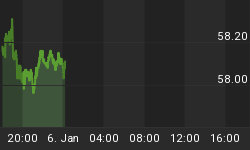The discrepancy between the ISM's Report on Business and Markit's Manufacturing PMI assessment of the economy widened today.
Both reports agree that cost inflation is rising quickly despite moderation in the price of oil.
ISM Commentary

The ISM noted 17 out of the 18 industries reported growth in March.
Here's the statement that caught my eye: "The past relationship between the PMI® and the overall economy indicates that the average PMI® for January through March (57 percent) corresponds to a 4.3 percent increase in real gross domestic product on an annualized basis."
On an over-under basis, I will take "the under" as in way under.
Markit Key Findings
- Manufacturing growth slows to six-month low in March
- Headline PMI eases to 53.3, down from 54.2 in February
- New orders rise at weakest pace since October 2016
- Input cost inflation hits two-and-a-half year high

Business conditions continued to improve across the manufacturing sector in March, but the latest upturn was the weakest recorded for six months. The loss of momentum reflected softer rates of output and new order growth, alongside a slower rise in payroll numbers. Manufacturers sought to adjust their inventory strategies in response to more subdued sales growth, with stocks of finished goods reduced for the first time in six months
Meanwhile, higher raw material prices resulted in the strongest rate of cost inflation since September 2014. Factory gate charges also increased at the fastest pace for around two-and-a-half years.
New orders expanded at the slowest pace since October 2016, thereby signalling a sustained loss of momentum from the peak seen at the start of the year. Manufacturers cited greater caution among clients, alongside intense competition for new work and subdued export sales.
Comments from Chris Williamson, Markit Chief Business Economist
- "The post-election resurgence of the manufacturing sector seen late last year is showing signs of losing steam. Output growth slowed to a six-month low in March, optimism about the outlook has waned and hiring has slowed accordingly."
- "While the survey data suggest that the goods producing sector enjoyed a relatively good first quarter on the whole, the loss of momentum seen in February and March bodes ill for the second quarter."
- "The survey data have acted as a reliable advance guide to official data in the past, and in March indicate a slowing of output growth to an annualized rate of around 2%. The survey's employment index is meanwhile consistent with official manufacturing payroll numbers falling slightly."
- "If the activity numbers send a dovish signal to policymakers, the survey's price indices favor the hawks. Inflationary pressures have risen to a two and a half year high, despite the oil price easing during the month."
Markit Services
Markit forecasts GDP with its services report, due April 5. The Markit Flash Services PMI on March 24 provides a strong hint.
Chris Williamson commented: "The US economy shifted down a gear in March. A slowing in the pace of growth signaled by the PMI surveys for a second straight month suggests that the economy is struggling to sustain momentum. The survey readings are consistent with annualized GDP growth of 1.7% in the first quarter, down from 1.9% in the final quarter of last year."
Williamson has had a pretty good read on GDP. He estimated 1.9% for the 4th quarter and the final came in at 2.1%.
Why the Discrepancy?
The ISM numbers have been consistently better than PMI numbers.
Since both are diffusion indices, and both measure the same industries, the numbers should align better than they do.
Stagflation Lite?
The one thing the reports agree on is price inflation. A slowing economy and rising prices is a stagflation lite scenario.
GDP Predictions
- GDPNow April 3: 1.2%
- ISM April 3: 4.3%
- FRBNY Nowcast March 31: 2.9%
- Markit March 24: 1.7%
The "advance" GDP number for the first quarter comes out on April 28.
















